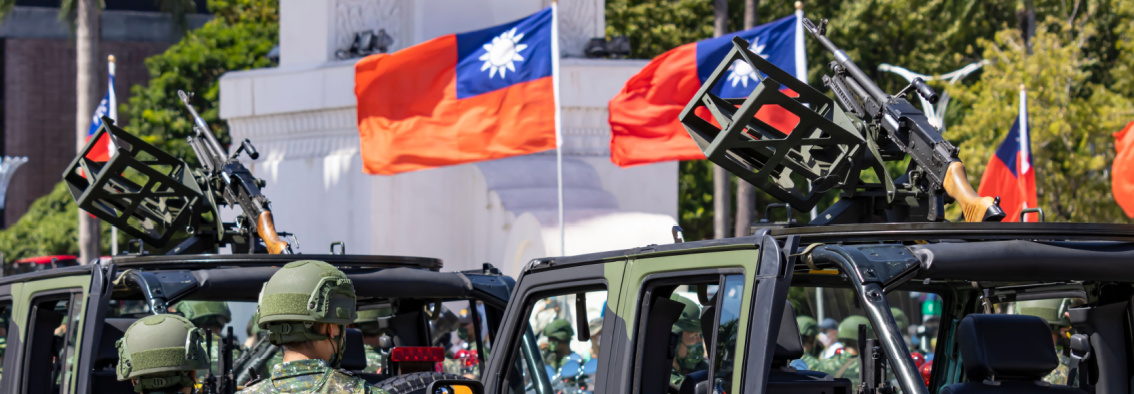It is undeniable that Taiwan faces an existential threat from a much larger and militarily superior counterpart across the Strait, the People’s Republic of China (PRC). Potentially facing an offensive by the Chinese military within the next several years, Taiwan has been looking for ways to bolster its defense. When considering various methods that Taiwan can use to defend itself from the authoritarian rule of the PRC, one possibility could be for the Taiwanese military to utilize its small but strong self-defense forces in a lethal doctrine akin to that of the current British military.
Taiwan’s Threat Matrix
Over the past several decades, Taiwan’s military has stagnated while the People’s Liberation Army (PLA) has rapidly grown. China, one of the world’s top militaries, now has a naval presence and an air force capable of blocking Taiwan. Beijing also has enough short and medium-range ballistic missiles to threaten Taipei and the US military in the region. Simultaneously, China has built man-made islands across Southeast Asia, which could also effectively be used as staging points for operations against Taiwan.
Despite preparing steps for major arms procurements to supplement the country’s defense, Taiwan must also consider the changing global landscape. Numerous large-scale wars and populist movements all threaten allied defense efforts against the looming threat from the Chinese Communist Party (CCP, 中國共產黨). Western indecision and turbulence in US politics have left Taipei in a precarious position, as full defense backing by the United States is no longer guaranteed. Nevertheless, potentially using British military doctrine—which emphasizes small-unit, rapid maneuver warfare—can help deter or defend against threats from Beijing.
The British Military Doctrine of Small Unit Precision
Similar to the Republic of China (ROC) Armed Forces, the British military has also regressed in size and force projection capability. Nevertheless, the British military’s high level of mission readiness and professionalism among small unit teams remains vital for both the United Kingdom and the North American Treaty Organization (NATO). The United Kingdom emphasizes several key points regarding its force readiness: maneuver warfare and mission command. Compensating for its lack of sizable land forces, the British military has conducted tactical research on small-unit dominance in urban warfare settings.
The reconstituted 2nd Battalion of the British Army, also known as the Yorkshire Regiment, is conducting studies on light forces in an urban environment. Additionally, the UK Royal Marines and United States Marine Corps (USMC) are jointly studying the concept of “Next Generation Combat Teams” (NGCT). Adding two phalanx platoons, the ten-member units that make up NGCTs are supplemented by mortars, surface-to-air missiles, artillery support, and various anti-armor weaponry. These NGCTs emphasize thorough and rigorous training. Moreover, NGCT teams are supplemented by unmanned systems, which focus on gathering intelligence, surveillance, targeting, and reconnaissance (commonly known as ISTAR).
The PRC is not only rapidly adapting to advanced warfare but has also constructed the world’s largest naval fleet. Monitoring, surveilling, and gathering intelligence on critical targets and chokepoints against a looming PLA amphibious assault will be a key task for Taipei. Because implementing ISTAR abilities in Taiwan is a top priority for the Taiwanese military, NGCTs would be in line with Taiwan’s strategic goals.
Utilizing Small-Unit Leadership
An amphibious landing by the PLA, accompanied by major aerial bombardment, would almost certainly include decapitation strikes directed against the ROC armed forces’ leadership. A countermeasure to such strike plans could be granting greater initiative to lower-echelon units, and enlisted personnel. Giving leeway for decision-making to lower enlisted personnel, such as non-commissioned officers (NCOs), is a critical component of the success of both the British Armed Forces and the US military (particularly the Marine Corps). The Taiwanese military should better learn to utilize this concept effectively. NCOs are the backbone of the Marine Corps. Corporals and sergeants can make critical decisions on the battlefield, provide mentorship to platoon-sized elements, and formulate plans as long as the overall objective is completed. Granting freedom for lower-ranking enlisted people to make decisions is a critical way for field commanders to enhance trust and motivate their subordinates.
Potentially facing the largest amphibious assault in history, lower-ranking enlisted personnel will face fears and self-doubts. To keep officers’ spirits up and reassure their subordinates that they will be beside them, it will be important for officers to set the tempo. Restricting officers’ freedom also could have disastrous effects—as seen recently in Syria when the Baathist army rapidly collapsed due to minimal care and motivation on the part of its officers, and a lack of general leadership within the Assad regime.
In the case of a potential PLA amphibious invasion, Taiwan’s punishing terrain and various choke points across the country could work in the ROC military’s favor, as NCOs can lead asymmetrical attacks that fulfill mission objectives. In addition to orders from generals, field officers can also employ command and control. In short, employment of the American and British NCO doctrine will be instrumental for the island’s defense. Suppose, for example, that a decapitation strike on command and control were to take place: in that case, NCOs and senior enlisted and field officers could take the lead in defending Taipei until allied forces arrive.
Applying the British Military Doctrine in Taiwan
The current number of Taiwan’s active-duty military service members is around 169,000 to 180,000 personnel. The country has compulsory military conscription, and the All-Out Defense Mobilization Agency (國防部全民防衛動員署) allows the Taiwanese government to mobilize (at least in theory) up to two million reservists. The proposed British doctrine of NGCT teams, which emphasizes urban and asymmetric warfare, could be instrumental to Taipei’s defense. Moreover, the United Kingdom’s doctrine on island defense—which builds on prior experiences in World War II and the Falklands War—emphasizes key terrain, mobilizing air defense and air forces, and maximizing localized military and civilian defense.
The PLA would look to both employ a naval blockade and quickly force a capitulation—striking key infrastructure, energy grids, and command and control centers across Taiwan. Accordingly, essential points from the British doctrine on island defense that Taiwan can utilize to bolster its defense include combined arms operations, deterrence through air defense, anti-ship missiles, and hampering the Chinese navy’s freedom of movement near the Taiwanese coastline. With faster and more mobile teams, the ROC military can wage an asymmetrical war against a PLA blockade and invasion.

Image: Soldiers of the Royal Yorkshire Regiment (British Army 2nd Regiment) conducting field training (undated photo). This regiment has played a leading role in the British military’s development of the “Next Generation Combat Team” concept. (Image source: Royal Yorkshire Regiment)
The primary focus of Taiwan’s military should be to show Beijing that the risks will outweigh the rewards in any invasion. Based on this, a counter-landing doctrine should be implemented. Due to Taiwan’s proximity to the PRC, an immediate strategy of holding while waiting for allied support to arrive will be critical. In a January 2023 War on the Rocks article, Marine Corps infantry and regional affairs officer Zach Ota stated that “a joint, multinational counter-landing doctrine provides a foundation for developing and integrating the defense capabilities of key militaries across the Western Pacific.”
What Taiwan Could Also Utilize for Defense
In supplementing Taiwan’s defense with more advanced Western weapons systems, Taipei will also need a major defense procurement bolster—which is currently already being planned, as Taiwan reportedly has aspirational plans to purchase an Aegis destroyer, 400 Patriot missiles, and several dozen F-35s. Nevertheless, the F-35 could remain in perpetual backlog as to not inflame tensions between Beijing and Washington. Anticipating one of the largest amphibious and aerial assaults in modern warfare, Taiwan’s main priority in defense procurements should be anti-ship missiles, surface-to-air missiles, and long-range rockets to strike key naval bases on the mainland.
Nevertheless, Taipei will be at a major disadvantage—not from its size and strength compared to China, but due to decades of international isolationism. After the loss of international recognition, the PRC has expanded not only diplomatic and trade relations, but also military exercises with other nations. Beijing’s officer corps and intelligence apparatus have the luxury of cooperating in defense and surveillance with other countries such as Russia, which is deeply engaged in a major conventional war of its own.
Meanwhile, Taipei’s officers have international contacts primarily with small numbers of American advisors. In order for Taiwanese field commanders to gain partnerships and experience on what to expect in a modern conflict, the officer corps will need greater exposure to military exercises in multiple foreign countries. Nevertheless, due to the diplomatic pressure exerted by the CCP, most countries will not accept such a proposal by Taipei, and much-needed lobbying will be needed by the United States to help the ROC engage in enhanced defense exercises and partnerships.
In the meantime, drone warfare, particularly involving first-person view (FPV) and fiber optics drones, are at the forefront of casualties in Russia’s invasion of Ukraine. Taiwan should take lessons from Ukrainian drone production and follow the designs of America’s and Britain’s anti-drone countermeasures.
The ROC Armed Forces more than ever must reinvigorate their defensive doctrine while simultaneously reconstituting units to meet the challenges posed by China. In an ever-changing environment of radically changing geopolitical landscapes, deterrence matters now more than ever.
The main point: Small unit tactical concepts, which emphasize the role of non-commissioned officers, and island defense doctrine developed by the British military could both be highly beneficial to Taiwan’s defense. By emphasizing key terrain, asymmetrical warfare, small-unit leadership, counter-landing operations, and air defense, Taiwan could show China that the costs of an invasion or blockade will far outweigh any reward.



